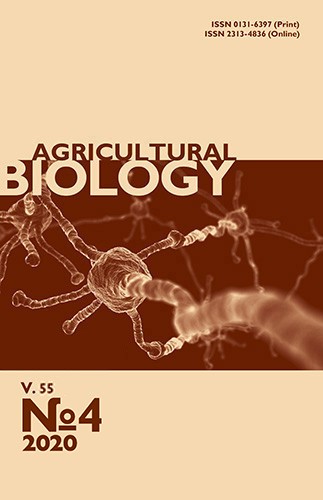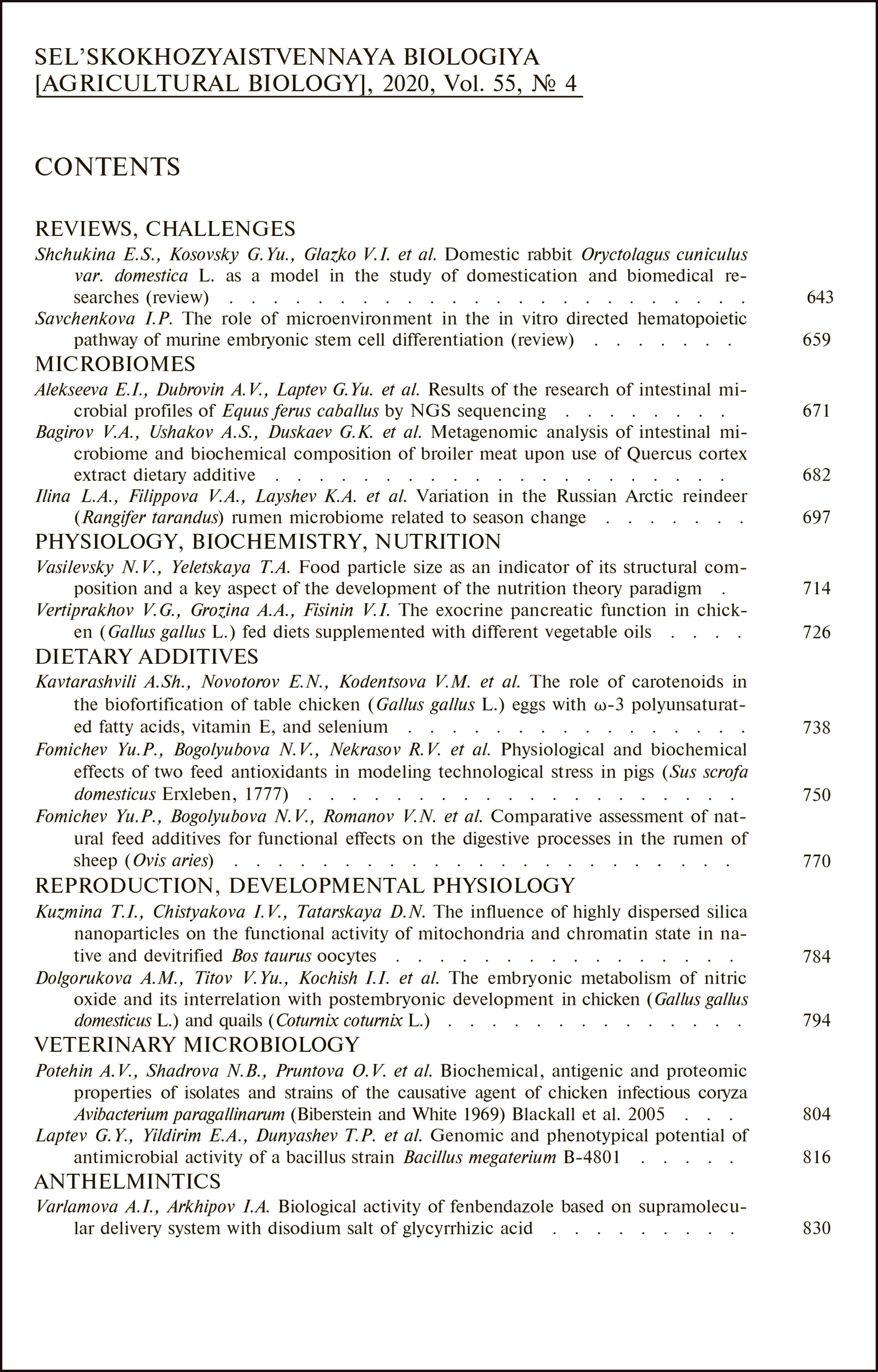doi: 10.15389/agrobiology.2020.4.738eng
UDC: 636.52.58:637.4.04.07
Acknowledgements:
Supported financially by Russian Science Foundation, grant No 16-16-04047
THE ROLE OF CAROTENOIDS IN THE BIOFORTIFICATION OF TABLE CHICKEN (Gallus gallus L.) EGGS WITH ω-3 POLYUNSATURATED FATTY ACIDS, VITAMIN E, AND SELENIUM
A.Sh. Kavtarashvili1, E.N. Novotorov1, V.M. Kodentsova2, D.V. Risnik3
1Federal Scientific Center All-Russian Research and Technological Poultry Institute RAS, 10, ul. Ptitsegradskaya, Sergiev Posad, Moscow Province, 141311 Russia, e-mail alexk@vnitip.ru (✉ corresponding author), en-5506040@mail.ru;
2Federal Research Centre of Nutrition, Biotechnology and Food Safety, 2/14, Ust’yinskii per., Moscow, 109240 Russia, e-mail kodentsova@ion.ru;
3Lomonosov Moscow State University, Faculty of Biology, 1-12, Leninskie Gory, Moscow, 119991 Russia, e-mail biant3@mail.ru
ORCID:
Kavtarashvili A.Sh. orcid.org/0000-0001-9108-1632
Kodentsova V.M. orcid.org/0000-0002-5288-1132
Novotorov E.N. orcid.org/0000-0003-4478-3206
Risnik D.V. orcid.org/0000-0002-3389-8115
Received December 13, 2019
Natural fortification of plant and animal derived foodstuffs with essential nutrients (biofortification) is regarded by modern nutritional science as an effective alternative for the synthetic food additives. Biofortified eggs are usually enriched with one or two target micronutrients via layer diets. However, the nutrition of the large part of the World’s population (both adult and infant) is characterized by the simultaneous deficiencies of different micronutrients: vitamins, carotenoids, minerals, and polyunsaturated fatty acids (PUFAs). The combined enrichment of foodstuffs with balanced set of the essential nutrients can compensate for these deficiencies and control the secondary deficiencies of the nutrients which can become deficient due to the changes in the diets of the patients. In the study presented the combined biofortification of table chicken eggs with four deficient micronutrients with different chemical and physiological properties was examined. The trial was performed in 2019 on four treatments of cage-housed Leghorn laying hens (Gallus gallus L., cross SP 789, 30 birds per treatment) during 60 days of the productive period. The concentrations of ω-6 and ω-3 PUFAs (from flaxseed oil and cake) in the diet for control treatment 1 were 2.18 and 1.97 %, respectively, ω-6/ω-3 ratio 1.11:1; the diet was also supplemented with vitamin E (150 ppm, as concentrated D-α-tocopherol) and selenium (0.5 ppm as 1:1 mixture of organic (Sel-Pleх®) and inorganic (sodium selenite) forms); the background concentration of carotenoids in this diet was 7.5 ppm. Treatments 2, 3, and 4 were fed the same diet additionally supplemented with 10; 14 and 18 ppm of carotenoids (as extract of the marigold, Tagetes erecta), respectively. The supplementation with carotenoids of diets containing the constant combination of other three target micronutrients (that we have studied in our previous trials) did not significantly affect the egg production (45.1-46.9 eggs per hen during 60 days of the trial), feed conversion ratios (1.58-1.63 kg of feed per 10 eggs and 2.43-2.50 kg of feed per 1 kg of eggs laid), and egg weight and morphology (average egg weight 65.0-65.2 g, yolk weight 18.1-18.3 g, albumen weight 39.3-39.7 g, eggshell weight 7.0-7.1 g) in layers. The eggs simultaneously fortified with the four micronutrients can be the valuable source of luthein, selenium, PUFAs, and vitamin E in human diet; these eggs could be also used as a component of multi-ingredient functional foodstuffs. The concentration of carotenoids in eggs increased with the increase in their concentration in layer diets. The increase in the concentration of the carotenoids in yolk enhanced the intensity of yolk coloration 1.66-1.84-fold, improving the market appearance and consumer attractibility of the eggs. The concentration of the four target micronutrients (per 100 g of edible part of the eggs) in the eggs from the treatment fed the highest dietary level of carotenoids were 0.7 mg for carotenoids, 62 μg for selenium, 10 mg for vitamin E, 417 mg for ω-3 PUFAs (with ω-6/ω-3 ratio 3.1:1), 3.96; 1.62; 4.37 and 2.42 times higher, respectively, in compare to “standard” (non-fortified) eggs. The daily consumption of one fortified egg will provide a consumer with 7.5 and 12 % of recommended daily consumption of ω-6 and ω-3 PUFAs, respectively, as well as 9; 39; 51 and 8 % of recommended daily consumption of vitamin A, vitamin E, selenium, and easily digestible carotenoids (primarily, lutein), respectively.
Keywords: biofortification, lutein, chickens, eggs, vitamin E, selenium, ω-3 PUFA.
REFERENCES
- Kodentsova V.M., Risnik D.V., Stefanova I.L. Ptitsaiptitseprodukty, 2019, 1: 27-29 CrossRef (in Russ.).
- Raederstorff D., Wyss A., Calder P. C., Weber P., Eggersdorfer M. Vitamin E function and requirements in relation to PUFA. British Journal of Nutrition, 2015, 114(8): 1113-1122 CrossRef
- Kavtarashvili A.Sh., Stefanova I.L., Svitkin V.S., Novotorov E.N. Functional egg production. I. The role of w-3 polyunsaturated fatty acids (review). Agricultural Biology [Sel'skokhozyaistvennaya biologiya], 2017, 52(2): 349-366 CrossRef
- Panaite T.D., Nour V., Vlaicu P.A., Ropota M., Corbu A.R., Saracila M. Flaxseed and dried tomato waste used together in laying hens diet. Archives of Animal Nutrition, 2019, 73(3): 222-238 CrossRef
- Leeson S., Namkung H., Caston L., Durosoy S., Schlegel P. Comparison of selenium levels and sources and dietary fat quality in diets for broiler breeders and layer hens. Poultry Science, 2008, 87(12): 2605-2612 CrossRef
- Kavtarashvili A.Sh., Stefanova I.L., Svitkin V.S., Novotorov E.N. Functional egg production. II. The roles of selenium, zinc, and iodine (review). Agricultural Biology [Sel'skokhozyaistvennaya biologiya], 2017, 52(4): 700-715 CrossRef
- Weill P., Schmitt B., Chesneau G., Daniel N., Safraou F., Legrand P. Effects of introducing linseed in livestock diet on blood fatty acid composition of consumers of animal products. Annals of Nutrition and Metabolism, 2002, 46(5): 182-191 CrossRef
- Lemahieu C., Bruneel C., Termote-Verhalle R., Muylaert K., Buyse J., Foubert I. Impact of feed supplementation with different omega-3 rich microalgae species on enrichment of eggs of laying hens. Food Chemistry, 2013, 141(4): 4051-4059 CrossRef
- Cachaldora P., García-Rebollar P., Alvarez C., Blas J.D., Méndez J. Effect of type and level of fish oil supplementation on yolk fat composition and n-3 fatty acids retention efficiency in laying hens. British Poultry Science, 2006, 47(1): 43-49 CrossRef
- Mazo V.K., Kavtarashvili A.Sh., Stefanova I.L., Kodentsova V.M., Bagryantseva O.V., Svitkin V.S., Novotorov E.N., Risnik D.V., Mokshantseva I.V., Sidorova Yu.S., Zorin S.N., Klimenkova A.Yu. Funktsional'nye yaitseprodukty [Functional egg products]. Moscow, 2018 (in Russ.).
- Díez-Espino J., Basterra-Gortari F.J., Salas-Salvadó J., Buil-Cosiales P., Corella D., Schröder H., Estruch R., Ros E., Gómez-Gracia E., Arós F., Fiol M., Lapetra J., Serra-Majem L., Pintó X., Babio N., Quiles L., Fito M., Marti A., Toledo E. Egg consumption and cardiovascular disease according to diabetic status: The PREDIMED study. Clinical Nutrition, 2017, 36(4): 1015-1021 CrossRef
- Chung H.Y., Rasmussen H.M., Johnson E.J. Lutein bioavailability is higher from lutein-enriched eggs than from supplements and spinach in men. The Journal of Nutrition, 2004, 134(8): 1887-1893.
- Park S.J., Jung J.H., Choi S.W., Lee H.J. Association between egg consumption and metabolic disease. Korean Journal for Food Science of Animal Resources, 2018, 38(2): 209-223 CrossRef
- Mah E., Chen C.O., Liska D.J. The effect of egg consumption on cardiometabolic health outcomes: an umbrella review. Public Health Nutrition, 2020, 23(5): 935-955 CrossRef
- Missimer A., DiMarco D.M., Andersen C.J., Murillo A.G., Vergara-Jimenez M., Luz Fernandez M. Consuming two eggs per day, as compared to an oatmeal breakfast, decreases plasma ghrelin while maintaining the LDL/HDL ratio. Nutrients, 2017, 9(2): 89 CrossRef
- Lieblein-Boff J.C., Johnson E.J., Kennedy A.D., Lai C.S., Kuchan M.J. Exploratory metabolomic analyses reveal compounds correlated with lutein concentration in frontal cortex, hippocampus, and occipital cortex of human infant brain. PLoS ONE, 2015, 10(8): e0136904 CrossRef
- Buscemi S., Corleo D., Di F.P., Petroni M.L., Satriano A., Marchesini G. The effect of lutein on eye and extra-eye health. Nutrients, 2018, 10(9): 1321 CrossRef
- Ames B.N. Prolonging healthy aging: longevity vitamins and proteins. Proceedings of the National Academy of Sciences, 2018, 115(43): 10836-0844 CrossRef
- Chung R.W.S., Leanderson P., Lundberg A.K., Jonasson L. Lutein exerts anti-inflammatory effects in patients with coronary artery disease. Atherosclerosis, 2017, 262: 87-93 CrossRef
- Akdemir F., Orhan C., Sahin N., Sahin K., Hayirli A. Tomato powder in laying hen diets: effects on concentrations of yolk carotenoids and lipid peroxidation. British Poultry Science, 2012, 53(5): 675-680 CrossRef
- Omri B., Alloui N., Durazzo A., Lucarini M., Aiello A., Romano R., Santini A., Abdouli H. Egg yolk antioxidants profiles: effect of diet supplementation with linseeds and tomato-red pepper mixture before and after storage. Foods, 2019, 8(8): 320 CrossRef
- Zahroojian N., Moravej H., Shivazad M. Comparison of marine algae (Spirulina platensis) and synthetic pigment in enhancing egg yolk colour of laying hens. British Poultry Science, 2011, 52(5): 584-588 CrossRef
- Afanas'ev G.D., Popova L.A., Komarchev A.S., Trepak Zh.G. Ptitsa i ptitseprodukty, 2014, 5: 62-64 (in Russ.).
- Kavtarashvili A.Sh., Stefanova I.L., Svitkin V.S. Functional egg production. III. The role of the carotenoids (review). Agricultural Biology [Sel'skokhozyaistvennaya biologiya], 2019, 54(4): 681-693 CrossRef
- Mokshina N.Ya., Khokhlov V.Yu., Shlyakhina Yu.V., Selemenov V.F. VestnikVGU. Seriya: KHimiya, Biologiya, Farmatsiya, 2003, 2: 53-55 (in Russ.).
- Englmaierová M., Skřivan M., Bubancová I. A comparison of lutein, spray-dried Chlorella, and synthetic carotenoids effects on yolk colour, oxidative stability, and reproductive performance of laying hens. Czech J. Anim. Sci., 2013, 58(9): 412-419 CrossRef
- Koshchaev A.G. Khranenie i pererabotka sel'khozsyr'ya, 2007, 2: 34-38 (in Russ.).
- Skřivan M., Marounek M., Englmaierova M., Skřivanova E. Effect of increasing doses of marigold (Tagetes erecta) flower extract on eggs carotenoids content, colour and oxidative stability. Journal of Animal and Feed Sciences, 2016, 25: 58-64 CrossRef
- Lokaewmanee K., Yamauchi K., Komori Ts., Saito K. Enhancement of yolk color in raw and boiled egg yolk with lutein from marigold flower meal and marigold flower extract. The Journal of Poultry Science, 2011, 48(1): 25-32 CrossRef
- Skřivan M., Englmaierová M., Skřivanová E., Bubancová I. Increase in lutein and zeaxanthin content in the eggs of hens fed marigold flower extract. Czech J. Anim. Sci., 2015, 60(3): 89-96 CrossRef
- Kodentsova V.M., Vrzhesinskaya O.A., Beketova N.A., Kodentsova O.V. Voprosy pitaniya, 2005, 5: 19-24 (in Russ.).
- Kavtarashvili A.Sh., Mazo V.K., Kodentsova V.M., Risnik D.V., Stefanova I.L. Biofortification of hen eggs: vitamins and carotenoids (review). Agricultural Biology [Sel'skokhozyaistvennaya biologiya], 2017, 52(6): 1094-1104 CrossRef
- MR 2.3.1.2432-08. Normy fiziologicheskikh potrebnostei v energii i pishchevykh veshchestvakh dlya razlichnykh grupp naseleniya Rossiiskoi Federatsii. Metodicheskie rekomendatsii [MR 2.3.1.2432-08. Norms of energy and nutrient physiological requirements for various groups of the population of the Russian Federation. Guidelines]. Moscow, 2009 (in Russ.).
- Edinye sanitarno-epidemiologicheskie i gigienicheskie trebovaniya k tovaram, podlezhashchim sanitarno-epidemiologicheskomu nadzoru (kontrolyu) Tamozhennogo soyuza EvrAzES (Prilozhenie 5) [Uniform sanitary, epidemiological and hygienic requirements for goods subject to sanitary and epidemiological supervision (control) of the EurAsEC Customs Union (Appendix 5)]. Moscow, 2010 (in Russ.).
- Kelly E.R., Plat J., Haenen G.R., Kijlstra A., Berendschot T.T. The effect of modified eggs and an egg-yolk based beverage on serum lutein and zeaxanthin concentrations and macular pigment optical density: results from a randomized trial. PLoS ONE, 2014, 9(3): e92659 CrossRef
- Heying E.K., Ziemer K.L., Tanumihardjo J.P., Palacios-Rojas N., Tanumihardjo S.A. β-Cryptoxanthin-biofortified hen eggs enhance vitamin A status when fed to male Mongolian Gerbils. The Journal of Nutrition, 2018, 148(8): 1236-1243 CrossRef
- Sowa M., Yu J., Palacios-Rojas N., Goltz S.R., Howe J.A., Davis C.R., Rocheford T., Tanumihardjo S.A. Retention of carotenoids in biofortified maize flour and β-cryptoxanthin-enhanced eggs after household cooking. ACS Omega, 2017, 2(10): 7320-7328 CrossRef
- Douny C., Khoury R.E., Delmelle J., Brose F., Degand G., Moula N., Farnir F., Clinquart A., Maghuin-Rogister G., Scippo M.-L. Effect of storage and cooking on the fatty acid profile of omega-3 enriched eggs and pork meat marketed in Belgium. Food Science & Nutrition, 2015, 3(2): 140-152 CrossRef
- Burns-Whitmore B., Haddad E., Sabaté J., Rajaram S. Effects of supplementing n-3 fatty acid enriched eggs and walnuts on cardiovascular disease risk markers in healthy free-living lacto-ovo-vegetarians: a randomized, crossover, free-living intervention study. Nutrition Journal, 2014, 13(1): 29 CrossRef
- Kim J.E., Ferruzzi M.G., Campbell W.W. Egg consumption increases vitamin E absorption from co-consumed raw mixed vegetables in healthy young men. The Journal of Nutrition, 2016, 146(11): 2199-2205 CrossRef
- Bessonova L.N., Antipova L.V., Cherkasova A.V. V sbornike: Nauka, pitanie i zdorov'e[In: Science, nutrition and health]. Minsk, 2019: 480-487 (in Russ.).












